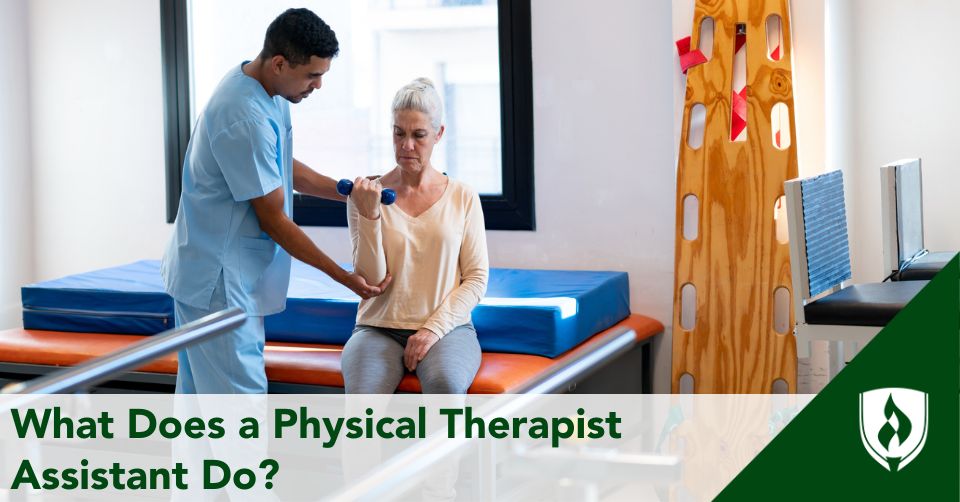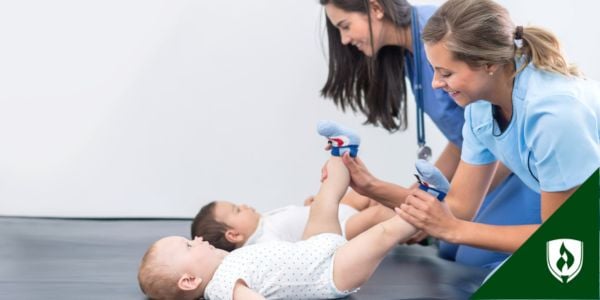
Since people only need physical therapy after injury or because of a certain illness, many don't understand what this role is really like. It goes so much deeper than moving patients around a gym or helping them perform exercises.
A physical therapist assistant (PTA) is the assistant to a physical therapist. Physical therapist assistants carry out the plan of care created by a licensed physical therapist. That's the short version.
But here's what working as a physical therapist assistant is really like.
Step one: Review charts
For most physical therapy providers, each day will start with reviewing the schedule for the day and reviewing patient charts and patient care plans.
Details such as what happened last time, therapeutic interventions, diagnosis, precautions and physical therapy goals help to plan my treatment sessions.
Step two: Meet the first patient
Once I meet my first patient for the day, I make sure to ask if anything is new. This can help me decide if the treatment I have planned needs to change in any way.
For example, if a patient says, "I fell last night," treatment may need to be discontinued until the supervising physical therapist or another medical professional (depending on the situation) can assess their situation.
I also ask the patient if they are having an easier time doing anything or if they have less pain to gauge how the plan of care is going. From there, I assess some of the physical therapy goals to see which ones they are meeting.
Step three: Begin the treatment session
Depending on the plan of care, physical therapist assistants might perform interventions like massage or passively mobilizing joints. They might utilize modalities such as ice packs and hot packs as well.
And for the most important part, the PTA will introduce therapeutic exercise to address decreased range of motion, decreased strength, control pain, or improve balance and gait activities to help the patient reach their treatment goals and return to normal activity.
I would also use this time to explain why I am doing the treatments and how they will impact the patient’s body and help them reach their treatment goals.
I would also likely use therapeutic exercises and activities after manual therapy. For example, if treating someone with non-acute back pain, we may do some manual therapy, followed by exercises, and then review proper lifting techniques to help them avoid reinjury.
Or if I were working in an inpatient physical therapy environment, the treatment session would be focused on improving functional mobility.
For example, if someone just had back surgery, I might teach them how to properly roll to their side before getting out of bed. I may walk with them and make sure they are moving their bodies in a way that helps them heal, while improving their independence so they can return home safely.
Step four: Build rapport with the patient
Physical therapist assistants will see the same patients many times over the course of their care. Developing a good working rapport with your patients is necessary. This means learning how to listen and motivate.
In my experience, motivating people comes down to finding out what they truly value.
If someone really enjoys golf, for example, you might incorporate a golf ball into your balance exercises. If someone really values time with their small grandchildren, you may point out how the exercises they are doing will help them have the strength to get up and down from the floor with a toddler.
Step five: Listen carefully
Many physical therapist assistants practice reflective listening, where they repeat back what the patient says, to make sure everyone is on the same page. This is very useful after injuries or illnesses that might make focus, attention or speaking difficult for the patient.
Listening is also a good way to gain trust. Patients will likely spend more time with their physical therapist assistant than with other healthcare professionals on the rehab team.
Each patient will see their PTA up to 7 times a week in inpatient settings and 2-3 times a week in outpatient settings. If you treat patients with careful attention, the trust and rapport you build with them will make the week better for everyone.
Step six: Repeat with the next patients!
You get the idea. The next patient arrives, and you'll do it all again—but in a totally different way with a different person and a different plan of care.
The main skill of the PTA is to choose appropriate, effective activities from the plan of care "menu" to help their patients move towards their functional movement goals. A physical therapist assistant is the designer of the treatment sessions that will help each patient achieve their goals.
Therapeutic activities can range from practicing functional movements such as walking or getting out of a chair to throwing drills for a baseball pitcher. The functional activities depend on what the patient is having difficulty doing and what their goals are. Patients may need to return to work or competitive sports or simply to care for themselves and their household.
Step seven: Take care of yourself throughout the day
Depending on where you are working, you might have a very different experience from one patient to the next.
One of the more challenging parts of being a physical therapist or a physical therapist assistant is that you usually meet people at a time when their life is not going too well.
Maybe they have had a major injury or been diagnosed with a progressive disease or are simply in a lot of pain. Most of us get into the profession because we care about others, and it's hard on us when we can't help someone get better. Sometimes, witnessing someone struggle to adjust to their new limitations and accept their circumstances is difficult.
Building in as much self-care as you can, whether that be something amazing for lunch, or a good talk with another member of the physical therapy team, is always a good idea.
Step eight: Celebrate. Every. Win.
This role can be amazing.
One of the most rewarding jobs I ever had was helping people with brain injuries re-integrate into the community. Nothing can beat the endeavor of helping someone regain their quality of life.
Many of my patients who could not move their own bodies after their injury returned to work or school and rebuilt their lives. I loved when they would come back for a visit, and I would be shocked at how different they were.
Most patients and their families are very grateful for what we do and express this in touching ways.
In one of my favorite moments on the job, I got to watch a family see their son's first steps as he learned to walk again after a serious car injury. Bearing witness to the resilience of the human spirit is an awe-inspiring experience.
Step nine: Write it all down
After the treatment sessions are done for the day, physical therapist assistants need to complete documentation for each treatment session. This is really an art, and it takes time to learn. Great physical therapist assistants use words to paint a picture of patient progress for anyone else who needs to know how the patient is doing.
Addressing misconceptions about the role of a PTA
As you can see, working as a physical therapist assistant is challenging, interesting and rewarding--but there are some things it's not. Here are some notes to clear up misconceptions and areas of confusion people often have about PTAs.
1. It's "physical therapist assistant" not "physical therapy assistant"
This is a common confusion! PTAs are physical therapist assistants not physical therapy assistants. It's a slight difference, but you might want the right term when you research.
2. A physical therapist assistant is not a personal trainer
Physical therapy services differ from personal training or fitness because the people in physical therapy are recovering from an injury or managing a disease process that has changed their ability to function and move. Physical therapy professionals must be adept regarding functional movement of the human body. This takes education and training.
All physical therapist assistants have a degree from a physical therapist assistant program and have passed The National Physical Therapy Exam (NPTE®) for PTAs.
3. Physical therapy includes many different specializations
Physical therapist assistants work in hospitals, rehab facilities, outpatient clinics, home health or even the school system. Physical therapist assistants can work with infants, children, adults and geriatrics. Some PTAs work with health promotion and fitness with special populations and help athletes return to their sport.
Some diagnoses that are common for PTAs to work with include problems like muscle strain, ligament sprain, bone fractures, tendinopathies, joint pain, spinal problems, amputations, heart and lung problems, and post-surgical patients.
PTAs can receive additional training to specialize in Acute Care, Cardiovascular and Pulmonary, Geriatrics, Neurology, Oncology, Orthopedics, Pediatrics or Wound Management if they have a desire to specialize.
Differences in specialty can also make a difference in what physical therapist assistants earn. The American Physical Therapy Association job board can show you a glimpse of how work environments, locations and specialties vary.
4. Physical therapists vs. PTAs
The physical therapist supervises the physical therapist assistant. They have the full clinical education to evaluate, diagnose and create a general plan of care. PTAs work within that plan of care, but do not have the authority to change it. The plan of care outlines diagnosis, prognosis, goals and which interventions can be used in treatment.
As far as treating patients goes, PTs and PTAs do roughly the same thing.
Rasmussen University does not offer any programs which lead to the career opportunity of Physical Therapist.
Physical therapist assistants do amazing work
As you can see, PTAs take on a lot. This is a wonderful career for people who love to work with others and who would prefer to be on their feet and work with their hands. It's also a great career for anyone who loves to make a difference in people's lives. If that might be you, check out How to Become a Physical Therapist Assistant (and Why You Should).
NPTE® is a registered trademark of Federation of State Boards of Physical Therapy




